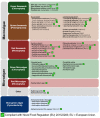The utility of algae as sources of high value nutritional ingredients, particularly for alternative/complementary proteins to improve human health
- PMID: 37904788
- PMCID: PMC10613476
- DOI: 10.3389/fnut.2023.1277343
The utility of algae as sources of high value nutritional ingredients, particularly for alternative/complementary proteins to improve human health
Abstract
As the global population continues to grow, the demand for dietary protein is rapidly increasing, necessitating the exploration of sustainable and nutritious protein sources. Algae has emerged as a promising food source due to their high value ingredients such as proteins, as well as for their environmental sustainability and abundance. However, knowledge gaps surrounding dietary recommendations and food applications restrict algae's utilization as a viable protein source. This review aims to address these gaps by assessing the suitability of both microalgae and macroalgae as alternative/complementary protein sources and exploring their potential applications in food products. The first section examines the potential suitability of algae as a major food source by analyzing the composition and bioavailability of key components in algal biomass, including proteins, lipids, dietary fiber, and micronutrients. Secondly, the biological effects of algae, particularly their impact on metabolic health are investigated with an emphasis on available clinical evidence. While evidence reveals protective effects of algae on glucose and lipid homeostasis as well as anti-inflammatory properties, further research is required to understand the longer-term impact of consuming algal protein, protein isolates, and concentrates on metabolic health, including protein metabolism. The review then explores the potential of algal proteins in food applications, including ways to overcome their sensory limitations, such as their dark pigmentation, taste, and odor, in order to improve consumer acceptance. To maximize algae's potential as a valuable protein source in the food sector, future research should prioritize the production of more acceptable algal biomass and explore new advances in food sciences and technology for improved consumer acceptance. Overall, this paper supports the potential utility of algae as a sustainable and healthy ingredient source for widespread use in future food production.
Keywords: algae; alternative protein; food applications; metabolic health; microalgae; nutrition; protein quality; seaweed.
Copyright © 2023 Wu, Tso, Teo and Haldar.
Conflict of interest statement
The authors declare that the research was conducted in the absence of any commercial or financial relationships that could be construed as a potential conflict of interest.
Figures


Similar articles
-
Algae as an alternative source of protein in poultry diets for sustainable production and disease resistance: present status and future considerations.Front Vet Sci. 2024 Apr 10;11:1382163. doi: 10.3389/fvets.2024.1382163. eCollection 2024. Front Vet Sci. 2024. PMID: 38659457 Free PMC article. Review.
-
Algal proteins: Production strategies and nutritional and functional properties.Bioresour Technol. 2021 Jul;332:125125. doi: 10.1016/j.biortech.2021.125125. Epub 2021 Apr 15. Bioresour Technol. 2021. PMID: 33865652 Review.
-
Algae as a Source of Natural Flavors in Innovative Foods.J Agric Food Chem. 2021 Oct 13;69(40):11753-11772. doi: 10.1021/acs.jafc.1c04409. Epub 2021 Oct 1. J Agric Food Chem. 2021. PMID: 34597023 Review.
-
Occurrence and Importance of Plant Lipids: A Promising Insight into Algae.Recent Pat Food Nutr Agric. 2017;8(3):166-174. doi: 10.2174/2212798409666170619101051. Recent Pat Food Nutr Agric. 2017. PMID: 28625124
-
Marine Algae: a Source of Biomass for Biotechnological Applications.Methods Mol Biol. 2015;1308:1-37. doi: 10.1007/978-1-4939-2684-8_1. Methods Mol Biol. 2015. PMID: 26108496
Cited by
-
Gas chromatography for analysis and estimation of 13C at natural abundance level in fatty acids produced from Aurantiochytrium limacinum, a sustainable source of polyunsaturated fatty acid.Front Bioeng Biotechnol. 2025 Jul 22;13:1631063. doi: 10.3389/fbioe.2025.1631063. eCollection 2025. Front Bioeng Biotechnol. 2025. PMID: 40766975 Free PMC article.
-
Eco-Friendly Extraction to Enhance Antioxidants and Nutritional Value in Arthrospira platensis.Foods. 2025 Apr 26;14(9):1510. doi: 10.3390/foods14091510. Foods. 2025. PMID: 40361593 Free PMC article.
-
Impact of Chlorella vulgaris powder on the nutritional content and preference of Khalas date spread.Front Nutr. 2025 Aug 13;12:1617754. doi: 10.3389/fnut.2025.1617754. eCollection 2025. Front Nutr. 2025. PMID: 40880744 Free PMC article.
-
Seaweed Proteins: A Step towards Sustainability?Nutrients. 2024 Apr 10;16(8):1123. doi: 10.3390/nu16081123. Nutrients. 2024. PMID: 38674814 Free PMC article. Review.
-
Chlorella vulgaris as a food substitute: Applications and benefits in the food industry.J Food Sci. 2024 Dec;89(12):8231-8247. doi: 10.1111/1750-3841.17529. Epub 2024 Nov 18. J Food Sci. 2024. PMID: 39556490 Free PMC article. Review.
References
-
- Clark H, Wu H. The sustainable development goals: 17 goals to transform our world: United Nations, (2016).
Publication types
LinkOut - more resources
Full Text Sources
Research Materials

